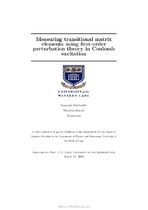Measuring transitional matrix elements using first-order perturbation theory in Coulomb excitation

View/
Date
2019Author
Masango, Senamile Khethekile Ntombizothando
Metadata
Show full item recordAbstract
The aim of nuclear structure physics is to study the interplay between singleparticle
and collective degrees of freedom in nuclei and to explain how nuclei
get excited and decay under di erent external conditions, such as strong electric
and magnetic elds. If nuclei absorb a large amount of energy and angular
momentum, like in a scattering reaction when you bombard a target that is in
the ground state with a projectile at high bombarding energies, the energy from
the projectile gets transfered to the target and vice versa, hence both projectile
and target may get excited. During the de-excitation process nuclei may release
the energy in a form of electromagnetic radiation (gamma rays) which carries
angular momentum.
The atomic nucleus is a many-body system, whose structure is de ned in terms
of interactions between protons and neutrons. In nature there are only around
300 stable isotopes [1]. They are all in their ground states (although some are in
a low-energy excited isomeric state with a long lifetime). To study excited states
in these nuclei one needs to provide energy to the system. In addition, there
are some 3000 unstable nuclei, most of which do not exist in nature. Many
have been produced and studied in research laboratories, and there could be
more than 3000 other unstable nuclei that can in principle exist in astrophysical
environments, but have not yet been synthesized on Earth [1].
